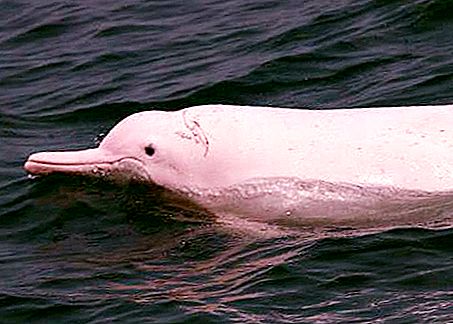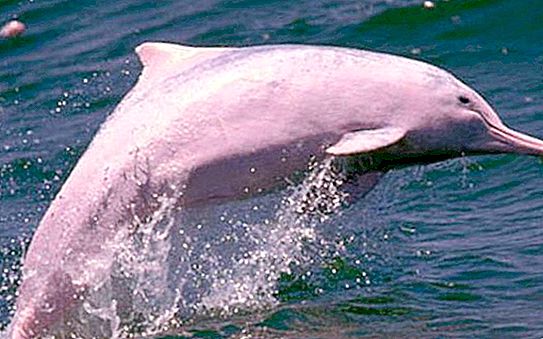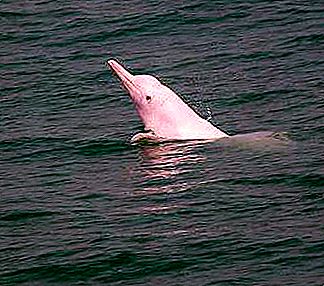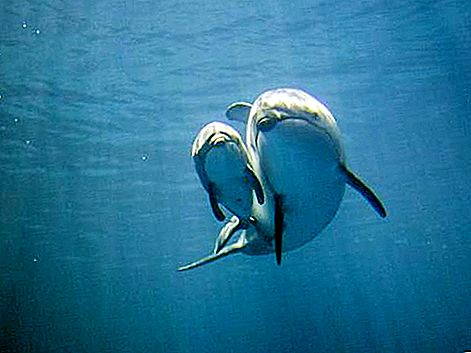In coastal waters, not more than 3 km from the coast, in shallow water, a surprisingly beautiful animal lives - the Chinese white dolphin, which belongs to the order of cetaceans.
Description
The length of the slender and strong body of this dolphin can be from 180 to 230 cm. The weight of an adult animal can reach 260 kg. The largest individuals are found in South African waters.

The ends of the broad pectoral fins are rounded. The dorsal one is like a flag. Beak narrow and long, slightly bent up. The forehead is slightly pinned, with a small hump. Due to this feature, the Chinese white dolphin received the name "humpback". Depending on the habitat, the shape of the body, as well as its color, are slightly different. There are pinkish-colored dolphin populations caused by blood vessels that appear through the skin.
The main food for these marine animals are eels, catfish, mollusks and crustaceans that live at the bottom. With the help of strong, having lateral outgrowths on wide roots, the dolphin’s teeth easily crush soft-shells.
They swim quite slowly - the average speed is an average of 4.8 kilometers per hour. Literally every 40-60 seconds, a dolphin has to swim to the surface to breathe air. The maximum time that some adults are able to stay under water is 8 minutes, while babies cannot hold their breath for a long time and are forced to emerge after 3 minutes.

Habitat
The Chinese white dolphin is found mainly in the coastal waters of southern China, the Bay of Bengal, in the Indo-Malayan archipelago, off the east coast of Northern Australia. Small populations are found in closed seas, for example, in the Persian Gulf. The comfortable depth for dolphins of this species does not exceed 100 meters; therefore, their distribution is limited by the coastal waters of the continental shelf. These animals are also seen, preferring open shores, in river mouths, rocky reef lagoons. The Chinese white dolphin usually lives in water, the temperature of which is 24-30 ° C.
Lifestyle
As a rule, these animals live in small groups - from 3 to 7 individuals. If necessary, they can stand up to protect their relatives. Often you can observe the communication of dolphins among themselves and with other species of animals. This occurs with the help of various sounds in the form of clicks, whistles and screams.
Dolphins are able to jump very high out of the water. Sometimes they protrude halfway, examining the surrounding space. They behave quite freely in the water - swimming on their sides or backs, a dolphin with a white belly does this with obvious pleasure.

Sometimes you can watch how these animals accompany the fishing vessel, trying to catch the fish running away from the fishing nets. At such moments they are very at risk of becoming entangled in the network themselves, a similar situation threatens them with death, because dolphins need to float to the surface in order to breathe.
Reproduction and care for offspring
Reaching adulthood occurs in females at 10 years old, in males two years later. The mating season lasts all year, but the period of active mating occurs in late summer. Pregnancy lasts quite a long time - about 10-12 months. Once every 3 years, the female gives birth to only one cub and does not wean it from the breast until almost two years of age, despite the fact that from six months the baby is able to eat the same food as a large white dolphin. Eating up to 30 times a day with mother’s fat milk, dolphins grow very quickly, adding up to 250 g in weight per day. During the first year of life, the cub does not leave the mother further than 2-3 meters, constantly circling around it.

The period of childbirth in females takes about 15 years - from 5 to 20 years. The life expectancy of white dolphins in vivo is approximately 40 years. In captivity, they practically do not survive.




